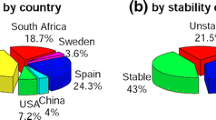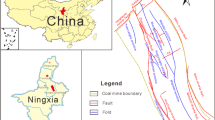Abstract
The prediction of open stope hangingwall (HW) stability is a crucial task for underground mines. In this paper, a relatively novel technique, the random forest (RF) algorithm, is introduced for the prediction of HW stability. The objective of this study is to verify the feasibility of the RF algorithm on HW stability prediction and investigate the relative importance of influencing variables. The training and verification of RF models were conducted on a dataset from the literature and a total of 115 HW cases were analysed. Thirteen influencing variables were selected as the inputs with the HW stability being selected as the output. The dataset was randomly divided into the training set and the testing set. Fivefold cross-validation was used as the validation method, and the grid search method was used for the hyper-parameters tuning. Performance measures were chosen to be the confusion matrix, the receiver operating characteristic (ROC) curve and the area under the ROC curve (AUC). The results show that the RF algorithm had great potential for the prediction of HW stability. AUC values achieved by the optimum RF model on the training set and the testing set were 0.884 and 0.873, respectively, indicating that the optimum RF model was excellent at predicting HW stability. The stope design method was found to be the most sensitive variable among all variables evaluated, with an importance score of 0.168 out of 1. The RQD and HW height also had a strong influence on the stability of an open stope HW.











Similar content being viewed by others
References
Amedjoe CG, Agyeman J (2015) Assessment of effective factors in performance of an open stope using cavity monitoring system data: a case study. J Geol Min Res 7:19–30
Barton N, Lien R, Lunde J (1974) Engineering classification of rock masses for the design of tunnel support. Rock Mech 6:189–236
Brady T, Pakalnis R, Clark L (2006) Design in weak rock masses: Nevada underground mining operations. Trans Soc Min Metall Exp Inc 318:182
Breiman L (2001) Random forests. Mach Learn 45:5–32
Breiman L, Friedman J, Stone CJ, Olshen RA (1984) Classification and regression trees. CRC Press, Boca Raton
Brokamp C, Jandarov R, Rao MB, LeMasters G, Ryan P (2017) Exposure assessment models for elemental components of particulate matter in an urban environment: a comparison of regression and random forest approaches. Atmos Environ 151:1–11. https://doi.org/10.1016/j.atmosenv.2016.11.066
Capes GW (2009) Open stope hangingwall design based on general and detailed data collection in unfavourable hangingwall conditions. Dissertation, University of Saskatchewan
Caruana R, Karampatziakis N, Yessenalina A (2008) An empirical evaluation of supervised learning in high dimensions. In: Proceedings of the 25th international conference on Machine learning, ACM, pp 96–103
Cepuritis P, Villaescusa E, Beck D, Varden R (2010) Back analysis of over-break in a longhole open stope operation using non-linear elasto-plastic numerical modelling. In: 44th US rock mechanics symposium and 5th US-Canada rock mechanics symposium, American rock mechanics association
Clark LM (1998) Minimizing dilution in open stope mining with a focus on stope design and narrow vein longhole blasting. Dissertation, University of British Columbia
Clark L, Pakalnis R (1997) An empirical design approach for estimating unplanned dilution from open stope hangingwalls and footwalls. In: Proceedings of the 99th annual general meeting, 1997. Canadian Institute of Mining, Metallurgy and Petroleum Vancouver
Deere DU (1962) Technical description of rock cores for engineering purposes. University of Illinois, Illinois
Diederichs M, Kaiser P (1999) Tensile strength and abutment relaxation as failure control mechanisms in underground excavations. Int J Rock Mech Min Sci 36:69–96
Friedman J, Hastie T, Tibshirani R (2001) The elements of statistical learning, vol 1. Springer, New York
Henning JG, Mitri HS (2007) Numerical modelling of ore dilution in blasthole stoping. Int J Rock Mech Min Sci 44:692–703
Henning JG, Mitri HS (2008) Assessment and control of ore dilution in long hole mining: case studies. Geotech Geol Eng 26:349–366
Hong H, Pourghasemi HR, Pourtaghi ZS (2016) Landslide susceptibility assessment in Lianhua County (China): a comparison between a random forest data mining technique and bivariate and multivariate statistical models. Geomorphology 259:105–118
Hosmer DW Jr, Lemeshow S, Sturdivant RX (2013) Applied logistic regression, vol 398. Wiley, Hoboken
Jang HD (2014) Unplanned dilution and ore-loss optimisation in underground mines via cooperative neuro-fuzzy network. Dissertation, Curtin University
Kohavi R (1995) A study of cross-validation and bootstrap for accuracy estimation and model selection. In: Ijcai, vol 2. Stanford, pp 1137–1145
Kohestani V, Hassanlourad M, Ardakani A (2015) Evaluation of liquefaction potential based on CPT data using random forest. Nat Hazards 79:1079–1089
Kuhn M, Johnson K (2013) Applied predictive modeling, vol 810. Springer, Berlin
Kuhnert PM, Henderson AK, Bartley R, Herr A (2010) Incorporating uncertainty in gully erosion calculations using the random forests modelling approach. Environmetrics 21:493–509
Lagomarsino D, Tofani V, Segoni S, Catani F, Casagli N (2017) A tool for classification and regression using random forest methodology: applications to landslide susceptibility mapping and soil thickness modeling. Environ Model Assess 22:201–214
Liaw A, Wiener M (2002) Classification and regression by randomForest. R News 2(3):18–22
Mawdesley C, Trueman R, Whiten W (2001) Extending the Mathews stability graph for open–stope design. Min Technol 110:27–39
Nateghi R, Guikema SD, Quiring SM (2014) Forecasting hurricane-induced power outage durations. Nat Hazards 74:1795–1811. https://doi.org/10.1007/s11069-014-1270-9
Nickson SD (1992) Cable support guidelines for underground hard rock mine operations. Dissertation, University of British Columbia
Potvin Y (1988) Empirical open stope design in Canada. Dissertation, University of British Columbia
Potvin Y, Hadjigeorgiou J (2001) The stability graph method for open-stope design In: Underground mining methods: engineering fundamentals and international case studies society of mining, metallurgy and exploration, 8307 Shaffer Parkway, Littleton, CO 80127, USA, pp 513–520
Qi C, Tang X (2018) Slope stability prediction using integrated metaheuristic and machine learning approaches: a comparative study. Comput Ind Eng. https://doi.org/10.1016/j.cie.2018.02.028
Qi C, Fourie A, Ma G, Tang X, Du X (2017) Comparative study of hybrid artificial intelligence approaches for predicting hangingwall stability. J Comput Civ Eng 32:04017086
Qi C, Fourie A, Chen Q (2018a) Neural network and particle swarm optimization for predicting the unconfined compressive strength of cemented paste backfill. Constr Build Mater 159:473–478
Qi C, Fourie A, Chen Q, Zhang Q (2018b) A strength prediction model using artificial intelligence for recycling waste tailings as cemented paste backfill. J Clean Prod 183:566–578
Rodriguez-Galiano V, Chica-Olmo M (2012) Land cover change analysis of a Mediterranean area in Spain using different sources of data: multi-seasonal Landsat images, land surface temperature, digital terrain models and texture. Appl Geogr 35:208–218
Rodriguez-Galiano V, Sanchez-Castillo M, Chica-Olmo M, Chica-Rivas M (2015) Machine learning predictive models for mineral prospectivity: an evaluation of neural networks, random forest, regression trees and support vector machines. Ore Geol Rev 71:804–818
Shimada H, Sasaoka T, Wattimena RK, Matsui K (2013) Influence of stope design on stability of hanging wall decline in cibaliung underground gold mine. Int J Geosci 4:1
Stewart S, Forsyth W (1995) The Mathew’s method for open stope design. CIM Bull 88:45–53
Wang J (2004) Influence of stress, undercutting, blasting and time on open stope stability and dilution. Dissertation, University of Saskatchewan 279
Wang J, Milne D, Wegner L, Reeves M (2007) Numerical evaluation of the effects of stress and excavation surface geometry on the zone of relaxation around open stope hanging walls. Int J Rock Mech Min Sci 44:289–298
Wanik DW, Anagnostou EN, Hartman BM, Frediani MEB, Astitha M (2015) Storm outage modeling for an electric distribution network in Northeastern USA. Nat Hazards 79:1359–1384. https://doi.org/10.1007/s11069-015-1908-2
Youden WJ (1950) Index for rating diagnostic tests. Cancer 3(1):32–35
Zhang K, Wu X, Niu R, Yang K, Zhao L (2017) The assessment of landslide susceptibility mapping using random forest and decision tree methods in the Three Gorges Reservoir area, China. Environ Earth Sci 76:405
Zhou J, Li X, Mitri HS (2015) Comparative performance of six supervised learning methods for the development of models of hard rock pillar stability prediction. Nat Hazards 79:291–316
Zhou J, Shi X, Du K, Qiu X, Li X, Mitri HS (2016) Feasibility of random-forest approach for prediction of ground settlements induced by the construction of a shield-driven tunnel. Int J Geomech 17:04016129
Acknowledgements
The first author was funded by China Scholarship Council (Grant No. 201606420046). The authors would like to thank Joanne Edmondston from Graduate Research school of The University of Western Australia for her valuable comments and suggestions which improved a previous version of this manuscript.
Author information
Authors and Affiliations
Corresponding author
Ethics declarations
Conflict of interest
The authors declare that they have no conflict of interest.
Rights and permissions
About this article
Cite this article
Qi, C., Fourie, A., Du, X. et al. Prediction of open stope hangingwall stability using random forests. Nat Hazards 92, 1179–1197 (2018). https://doi.org/10.1007/s11069-018-3246-7
Received:
Accepted:
Published:
Issue Date:
DOI: https://doi.org/10.1007/s11069-018-3246-7




